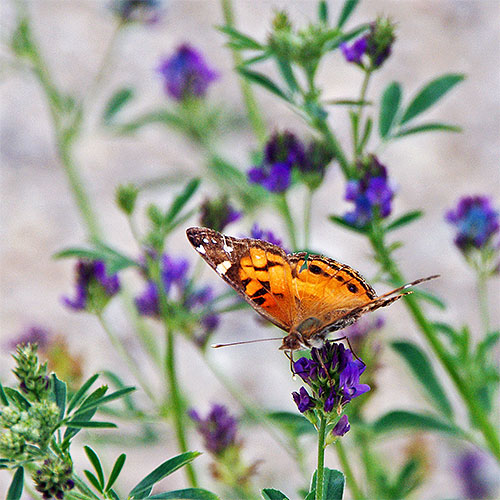Howdy, BugFans,
The Painted Lady (Vanessa cardui) is a lovely, unpredictable summer visitor here in God’s Country. Also called the Thistle Butterfly and the Cosmopolitan, it can be seen in temperate areas on five continents and may have the biggest range of any butterfly. Not only does it live in a lot of places, it migrates to even more. As a result, it is a very popular butterfly about which much is posted on-line, and it is a butterfly with a research site and fan clubs.
Painted Lady Butterflies
Painted Ladies (PLs) are members of the Brush-footed butterfly family, Nymphalidae, a large group of (often) medium-sized, orangey butterflies. “Brush-foot” comes from the bristles on their front pair of legs. The genus Vanessa includes the (very similar) American Lady and the Red Admiral, both of which also wander.
Look for PLs in open, sunny areas—fields, road edges, gardens, dunes. There the adults sip nectar, especially from thistle and clover flowers, and males defend their territories from perches. PLs fly north in mid-spring and there are probably two broods per summer here. Eggs are laid on caterpillar food plants like hollyhock, nettle, lupine, plus thistle and many other plants in the aster family (its catholic eating habits explain its five-continent range). Caterpillars attach themselves to their food plants using a rope of silk while they are eating. When they are ready to pupate, they hang upside-down from a leaf, using a silk fastener, and there they form a chrysalis. PLs, as caterpillars or adults, are preyed on by ants, parasitic wasps, spiders and birds.
PLs fly year-round in the southern and western U.S. and Mexico. They are seen in Wisconsin in small numbers every summer, but some years, when the southern populations boom or the weather conditions are right, PLs head north in dramatic flights. It is too cold here in Wisconsin for either the chrysalis or the adult to overwinter, so PLs must re-colonize each year.
There are some interesting theories about a possible/partial correlation between el Nino weather cycles and PL migrations, both here and on the other continents where they both (PLs and el Ninos) occur. Some populations of PLs live in very dry or in very rainy areas. Because a series of bad/low caterpillar years could devastate such a population, spreading out to different landscapes seems like a good idea, and migration is “built-in” to the butterflies’ behavior. Storm patterns change during el Nino years, often bringing more rain to the desert. The desert responds with a spectacular array of flowers, PLs breed like bunnies, and the resulting caterpillars strip the vegetation. When those caterpillars emerge as adults, the green is gone (just so many pieces of frass), so they pick up and look elsewhere. Many die, but enough find a habitable breeding area where their “food-generalist” caterpillars can thrive.
Is there comparable a southward migration? The scribes disagree on both the “whether” and the “why.” One source speculated that their southward migrations simply may not be as dramatic. PLs are permanent residents along the southern tier of states, so a southern migration isn’t necessary to maintain those populations. One researcher questions whether, if they didn’t fly south, there would be any individuals left that retained a migratory instinct. Since any PL north of the Mason-Dixon Line is a goner come winter, the theory goes, migrators need to head south again so there will be more migrators to head north again. The BugLady doesn’t know how the Migratory Instinct Theory jibes with the el Nino Plant Boom/Bust Theory and the Random Migration theory.
About that research site. You can visit the Vanessa Migration Project site and find out how your observations as a Citizen Scientist can add to the knowledge about the Vanessas.
The BugLady

